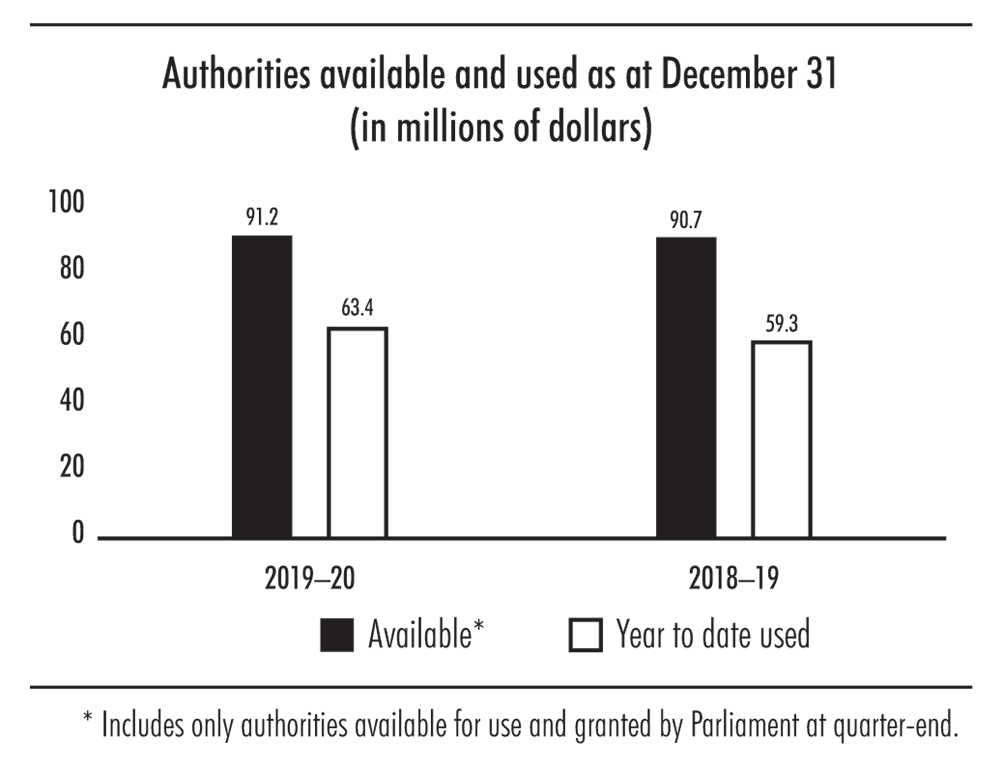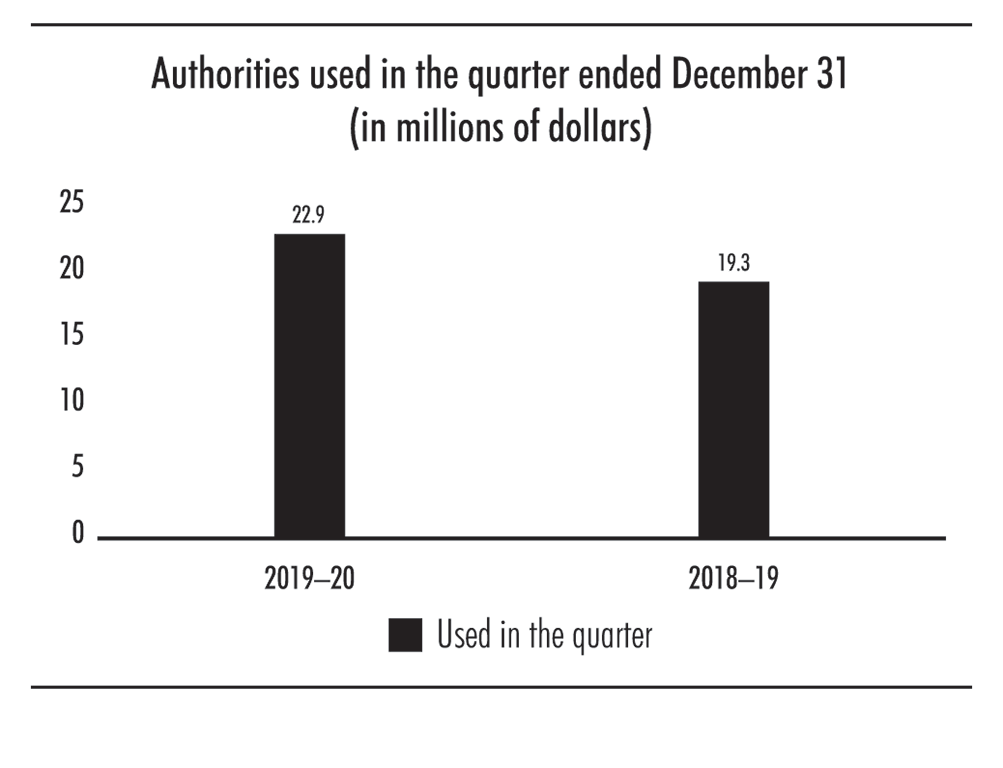Office of the Auditor General of Canada—Quarterly Financial Report for the quarter ended 31 December 2019
Office of the Auditor General of Canada Quarterly Financial Report for the quarter ended 31 December 2019
Statement outlining results, risks, and significant changes in operations, personnel, and program
Introduction
This quarterly report has been prepared by management as required by section 65.1 of the Financial Administration Act and in the form and manner prescribed by the Treasury Board, and it should be read in conjunction with the Main Estimates. This quarterly report has not been subject to an external audit or review.
The Office of the Auditor General of Canada (OAG) has 1 program activity: legislative auditing. The OAG conducts independent audits and studies that provide objective information, advice, and assurance to Parliament, government, and Canadians.
Mandate
The Auditor General of Canada is an Officer of Parliament, who is independent from the government and reports directly to Parliament. The duties are set out in the Auditor General Act, the Financial Administration Act, and other acts and orders-in-council. These duties relate to legislative auditing and, in certain cases, to monitoring of federal departments and agencies, Crown corporations, territorial governments, and other entities.
Basis of presentation
This quarterly report has been prepared by management using an expenditure basis of accounting. The accompanying Statement of Authorities includes the OAG’s spending authorities granted by Parliament and those used by the OAG, consistent with the Main Estimates for the 2019–20 fiscal year. This quarterly report provides financial information on the use of spending authorities. The OAG uses the full accrual method of accounting to prepare and present its annual financial statements that are part of the departmental results reporting process. However, the spending authorities voted by Parliament remain on an expenditure basis.
Highlights of quarterly and year-to-date results
The authorities used increased as a result of the growing workforce, the economic salary increases, and the revised salary structure that was announced in the first quarter of the 2019–20 fiscal year. The revised salary structure involved converting from a broadband to a lock-step structure to simplify the pay process.

Figure 1—text version
Authorities available and used as at December 31
(in millions of dollars)
| AvailableNote * | Year to date used | |
|---|---|---|
| 2019–20 | 91.2 | 63.4 |
| 2018–19 | 90.7 | 59.3 |

Figure 2—text version
Authorities used in the quarter ended December 31
(in millions of dollars)
- 2019–20: 22.9
- 2018–19: 19.3
Risks and uncertainties
The key risk for the OAG is its ability to effectively acquire, develop, and use new technologies and methodologies to keep pace with the changing audit environment. Managing this risk means that the OAG must invest in its information technology security and architecture, including the modernization of audit tools and emerging technologies. Accordingly, the OAG has had to reduce the number of performance audits that it conducts.
Significant changes in operations, personnel, and program
There were no significant changes in operations, personnel, and program during the third quarter of the 2019–20 fiscal year.
Approved by:
[Original signed by]
Sylvain Ricard, Chartered Professional AccountantCPA, Chartered AccountantCA
Interim Auditor General of Canada
[Original signed by]
Lucie Cardinal, Chartered Professional AccountantCPA, Chartered AccountantCA
Assistant Auditor General
and Chief Financial Officer
Ottawa, Canada
28 February 2020
Statement of authorities (unaudited)
(in thousands of dollars)
| Fiscal year 2019–20 | Fiscal year 2018–19 | |||||
|---|---|---|---|---|---|---|
| Total available for use for the year ending 31 March 2020Footnote * | Used during the quarter ended 31 December 2019 | Year to date used at quarter-end | Total available for use for the year ended 31 March 2019Footnote * | Used during the quarter ended 31 December 2018 | Year to date used at quarter-end | |
| Vote 1—Program expenditures | 83,733 | 21,079 | 57,151 | 83,365 | 17,040 | 52,805 |
| Less revenues netted against program expenditures | (2,660) | (710) | (1,366) | (2,660) | (11) | (371) |
| Net Vote 1—Program expenditures | 81,073 | 20,369 | 55,785 | 80,705 | 17,029 | 52,434 |
| Budgetary statutory authorities | 10,154 | 2,538 | 7,615 | 9,957 | 2,299 | 6,897 |
| Total budgetary authorities | 91,227 | 22,907 | 63,400 | 90,662 | 19,328 | 59,331 |
| Non-budgetary authorities | – | – | – | – | – | – |
| Total authorities | 91,227 | 22,907 | 63,400 | 90,662 | 19,328 | 59,331 |
Departmental budgetary expenditures by standard object (unaudited)
(in thousands of dollars)
| Fiscal year 2019–20 | Fiscal year 2018–19 | |||||
|---|---|---|---|---|---|---|
| Planned expenditures for the year ending 31 March 2020 | Expended during the quarter ended 31 December 2019 | Year to date expended at quarter-end | Planned expenditures for the year ended 31 March 2019 | Expended during the quarter ended 31 December 2018 | Year to date expended at quarter-end | |
| Expenditures: | ||||||
|
Personnel
|
79,507 | 20,478 | 55,514 | 78,942 | 16,940 | 51,468 |
|
Transportation and communications
|
3,837 | 1,007 | 2,982 | 4,034 | 810 | 2,398 |
|
Information
|
651 | 272 | 494 | 722 | 130 | 447 |
|
Professional and special services
|
6,367 | 1,562 | 4,051 | 6,752 | 1,012 | 3,777 |
|
Rentals
|
1,654 | 159 | 1,056 | 1,385 | 135 | 980 |
|
Repair and maintenance
|
298 | 26 | 100 | 341 | 25 | 82 |
|
Utilities, materials and supplies
|
307 | 44 | 125 | 270 | 51 | 119 |
|
Acquisition of machinery and equipment
|
1,232 | 60 | 426 | 844 | 236 | 422 |
|
Other subsidies and payments
|
34 | 9 | 18 | 32 | – | 9 |
|
Total gross budgetary expenditures
|
93,887 | 23,617 | 64,766 | 93,322 | 19,339 | 59,702 |
| Less revenues netted against expenditures: | ||||||
|
Costs recovered
|
||||||
|
Members of the Canadian Council of Legislative Auditors (CCOLA)
|
(660) | (41) | (164) | (660) | (11) | (159) |
|
International audit
|
(2,000) | (669) | (1,202) | (2,000) | – | (212) |
|
Total cost recovered
|
(2,660) | (710) | (1,366) | (2,660) | (11) | (371) |
| Total net budgetary expenditures | 91,227 | 22,907 | 63,400 | 90,662 | 19,328 | 59,331 |